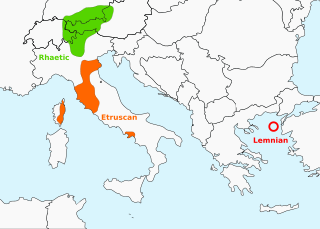| Rhaetic | |
|---|---|
| Raetic | |
| 𐤫𐤠ᛖ𐤠ᛩ | |
| Pronunciation | [ˈr̪ɑʃn̪ɑ] |
| Native to | Ancient Rhaetia |
| Region | Eastern Alps, Italy, Austria, Switzerland, Germany, Slovenia[1] |
| Ethnicity | Rhaetian people |
| Era | 5th–1st centuries BC[2] |
Tyrsenian
| |
| Language codes | |
| ISO 639-3 | xrr |
xrr | |
| Glottolog | raet1238 |
 | |
Rhaetic or Raetic (/ˈriːtɪk/), also known as Rhaetian,[3] was a Tyrsenian language spoken in the ancient region of Rhaetia in the eastern Alps in pre-Roman and Roman times. It is documented by around 280 texts dated from the 5th up until the 1st century BC, which were found through northern Italy, southern Germany, eastern Switzerland, Slovenia and western Austria,[4][2] in two variants of the Old Italic scripts.[5] Rhaetic is largely accepted as being closely related to Etruscan.[6]
The ancient Rhaetic language is not to be confused with the modern Romance languages of the same Alpine region, known as Rhaeto-Romance.
- ^ Schumacher, Stefan; Kluge, Sindy (2013–2017). Salomon, Corinna (ed.). "Thesaurus Inscriptionum Raeticarum". Department of Linguistics. of the University of Vienna
- ^ a b "Script". Thesaurus Inscriptionum Raeticarum. Retrieved 2024-06-04.
- ^ Silvestri & Tomezzoli 2007.
- ^ Marchesini 2018.
- ^ Salomon 2020.
- ^ Wallace 2010, pp. 97–102:Etruscan origins lie in the distant past. Despite the claim by Herodotus, who wrote that Etruscans migrated to Italy from Lydia in the eastern Mediterranean, there is no material or linguistic evidence to support this. Etruscan material culture developed in an unbroken chain from Bronze Age antecedents. As for linguistic relationships, Lydian is an Indo-European language. Lemnian, which is attested by a few inscriptions discovered near Kamania on the island of Lemnos, was a dialect of Etruscan introduced to the island by commercial adventurers. Linguistic similarities connecting Etruscan with Raetic, a language spoken in the sub-Alpine regions of northeastern Italy, further militate against the idea of eastern origins.